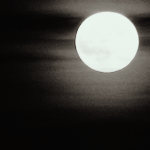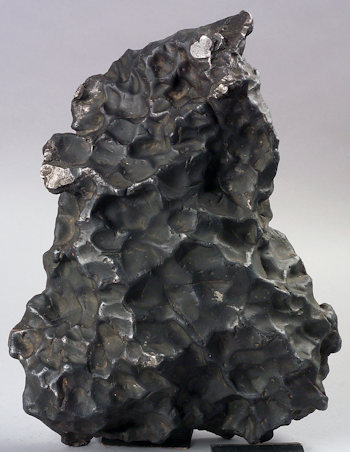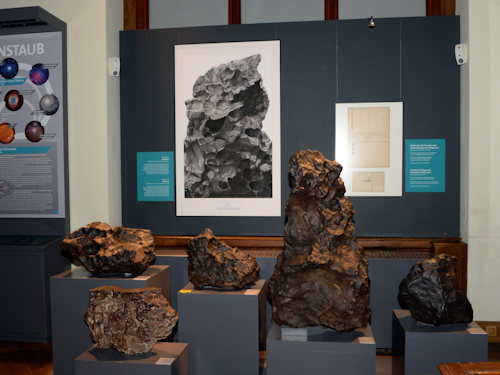
All great collections have to begin somewhere. The world-famous meteorite collection of the Natural History Museum (NHM) has its origins in the fall to earth of the Hraschina meteorite in 1751.
- Found in Croatia and delivered to Emperor Franz Stephan in Vienna
- 39kg iron meteorite that played a key role in advancing the science of meteoritics
- On display in Hall V of the museum
- See also:
The start of the meteorite collection

(The Hraschina meteorite © NHM Wien, A. Schumacher)
Large lumps of iron rarely attract particular interest. Unless they arrive from outer space, of course.
Imagine an ordinary Sunday in the spring of 1751 in Hraschina, a small village north of Zagreb in what is now modern-day Croatia.
Just as the locals were enjoying a late stroll and looking forward to supper, a rather unusual sight shattered the evening peace: an object falling from the sky in a trail of cloud.
According to eyewitnesses, the unexpected visitor from the heavens exploded into two pieces before hitting the ground.
In a show of remarkable pragmatism, the inhabitants of Hraschina broke up the smaller piece and used parts for nails. “Waste not, want not,” you might say.
Fortunately for the science of meteoritics, the Emperor in Vienna requisitioned the larger 39kg piece (back then, the area formed part of the Habsburg dominions). Kaiser Franz Stephan, husband of the actual ruler (Maria Theresa), was noted for his interest in natural phenomena.
The meteorite’s arrival in Hraschina and journey to Vienna proved pivotal in scientific history.
For example, this was one of the first such incidents to be properly documented (on Franz Stephan’s initiative). The origins of meteorites remained a matter of dispute in the 1700s, with scholars believing they came from volcanoes. The Hraschina example contributed significantly to the later development and acceptance of the extraterrestrial theory.
The meteorite’s appearance in Vienna also catalysed efforts to find similar examples from elsewhere, thereby laying the foundation for the collection we can see today in the Natural History Museum. This Meteoritensammlung is considered one of the largest and most prestigious of its kind.
And, on top of all that, one Alois von Widmannstätten was surprised to find patterns in nitric-acid treated samples taken from this meteorite.
Although Alois was not the first to record this phenomenon, these characteristic patterns bear Widmannstätten’s name today and remain in use as a way to identify, for example, whether a piece of iron truly comes from a meteorite.
Where to see it

(Anniversary installation around the Hraschina meteorite © NHM Wien, A. Schumacher)
Should you wish a closer look at the famous Hraschina meteorite, then see a full 3D representation here.
Alternatively, view it in the Natural History Museum’s Gallery 5 on the first floor in among many other similar examples (and even a lunar meteorite).
Such is the object’s fame that they even incorporated its image into the interior design of the museum building, which was constructed in the late 19th century.
Pop into Gallery 4 (gemstones and precious metals) and look at the sculpted figures along the walls. One well-muscled fellow holds a model of the meteorite in their hands.
May 26th 2021 marked the 270th anniversary of that fateful day in Hraschina, so the museum put up a small temporary installation in honour of the event. This included two drawings from 1751 that depicted accounts of the incident.
At the other end of the historical scale, a work by contemporary artist Florian Raditsch reproduced the meteorite in charcoal. The special installation remained on view until July 5th, 2021.
Check the main museum article for more details on the joys within the NHM.